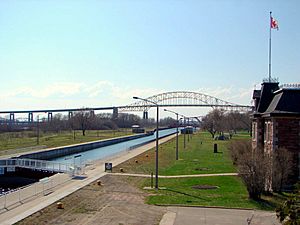Sault Ste. Marie Canal facts for kids
Quick facts for kids Sault Ste. Marie Canal |
|
|---|---|

The Sault Ste. Marie Canal National Historic Site, with the Sault Ste. Marie International Bridge in the background.
|
|
| Location | Sault Ste. Marie, Ontario |
| Built | 1895 |
| Governing body | Parks Canada |
| Website | Sault Ste. Marie Canal |
The Sault Ste. Marie Canal is a special place in Sault Ste. Marie, Ontario. It's a National Historic Site, which means it's an important part of Canada's past. Parks Canada looks after it.
This canal has a special water elevator, called a lock. It helps boats get around the fast-moving water, or rapids, on the St. Marys River.
The very first canal here was built in 1798. But it was destroyed in 1814 during a conflict called the War of 1812. The canal you see today was finished in 1895. It was a key part of the shipping route from the Atlantic Ocean all the way to Lake Superior. There are also two other locks on the US side of the river, known as the Soo Locks.
In 1987, one of the lock walls broke, and the canal had to close for big ships. A smaller lock was opened in 1998 inside the old one. This new lock is perfect for smaller boats and people who enjoy boating for fun.
Contents
A Look Back: The Canal's Story
The First Canal and the War of 1812
The very first lock was built in 1798 by a company called the North West Company. It helped their fur trading boats move along the river.
However, in 1814, during the War of 1812 between the United States and Great Britain, American forces attacked the area. They destroyed the North West Company's buildings and the lock.
Building Canada's Own Canal
Years later, in 1870, a Canadian ship called the Chicora was carrying soldiers. The United States would not let this ship pass through their locks at Sault Ste. Marie. This event, known as the Chicora Incident, made Canada decide to build its own canal.
Building the Canadian Sault Ste. Marie Canal was a big project. It was finally finished in 1895. When it opened, it was the largest lock in the world. It was also the first lock ever to be operated using electricity! The canal itself is about 1.6 kilometers (1 mile) long. The original lock was 274 meters (899 feet) long and 18 meters (59 feet) wide.
A Big Accident and Quick Fix
On June 9, 1909, a surprising accident happened at the lock. A ship called the Perry G. Walker was approaching the closed lower gates. There was a mix-up between the captain and the engineer. The ship crashed into the gate at about 6 miles per hour.
This crash caused a lot of damage. The water inside the lock rushed out very quickly, carrying three ships with it. Luckily, no one was hurt in this big event! An amazing safety device, called the Emergency Swing Dam, was used to stop the water. Repairs were done super fast, and the lock was open again in just 12 days.
A New Lock for Smaller Boats
In 1987, a wall of the historic lock broke. This meant the old lock could no longer be used for large ships. But Canada still needed a way for boats to pass.
So, a new, smaller lock was built right inside the old one. It opened in 1998. This new lock is 77 meters (253 feet) long and 15.4 meters (50.5 feet) wide. Today, it's mostly used by recreational boats and tour boats. Big cargo ships still use the Soo Locks on the US side of the river.
A Special Place: National Historic Site
Exploring the Canal Today
The Sault Ste. Marie Canal was named a National Historic Site in 1987. Parks Canada manages it as part of Canada's national park system. It's a great place for people to visit, whether they are on a boat or exploring on land.
There are several old buildings on the site that are part of its history. These include the administration building, the superintendent's house, and the powerhouse. They are all made from red sandstone that was dug up when the canal was built. Many of the original machines that ran the lock are still there too.
One very special feature is the Sault Canal Emergency Swing Dam. It's the only emergency swing dam like it left in the world. It's also the only one that was ever actually used in a real emergency, like the one in 1909!
If you visit in the summer, you can take a guided tour. The visitor centre is open from mid-June to mid-October.
Images for kids
-
Ponds with Brasenia schreberi along the Attikamek Trail
See also
- List of national historic sites of Canada
- Soo Locks - Locks on the U.S. side of St. Marys River
- Whitefish Island









